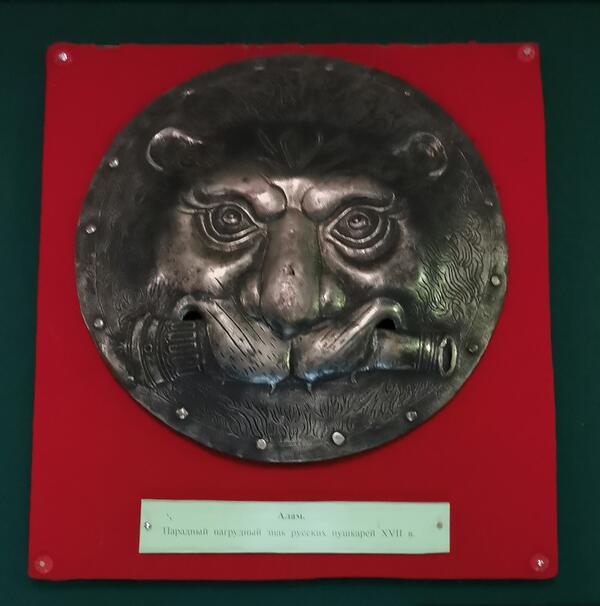In the 15th–17th centuries, the so-called mirror armor, additional protection on plate armor or chain mail, was brought from Russia to Iran. The Iranian armor was called “chahār-āyneh” (“four eyes”) and consisted of four plates: the backplate and breastplate were round, rectangular or octagonal, while the side “boards” were rectangular.
Analogues of such armor were alams — round plaques made of steel or copper, 28–30 cm in diameter. They were often decorated with a painted, notched or embossed image. Translated from Persian, “alam” means “a sign, a decoration on a dress”. In Russian historical sources, it was also called “olam” or “olom”. In the first half of the 17th century, it was customary to sew them on outerwear.
In the 1660s and 1670s, both artillery batteries and large units like the “New Order Regiment of Divisional General Mikolay Bovman” were being formed in Russia.
In 1664, the English envoy Charles Howard, 1st Earl of Carlisle, came to Moscow. In his honor, a showcase for the sovereign was to be held on the Maidens’ Field. “For the cannoneers”, red and green caftans with silver patches and tin armor branded with the image of guns were made. In addition, gilded copper disks were issued by the Silver Chamber. Eagles were emblazoned on them: the double-headed eagles held swords and cannons in their paws, the single-headed ones held cannons and linstocks. The edges of the “disks” were upholstered in scarlet, black or green velvet with a white leather lining. Belt straps were also covered with multicolored velvet.
The cannoneers were divided into privileged the “Moscow” and less honorable “city” gunners. It is possible that the decorated alams were given only to the Moscow gunners for ceremonial showcases and demonstrative maneuvers. Regimental and city officers wore smooth mirror plates.
In total, it was possible to determine that there were five variants of images that could feature a lion’s face, an eagle’s head, a single-headed eagle holding a finger and a cannon, a double-headed one with a cannon and a sword, or a double-headed one with a cannon and a linstock.
Two pairs of original alams of Russian cannoneers, decorated with lion’s faces, are kept in the collection of the Armory Chamber of the Moscow Kremlin.
Lion’s faces are carved on one of the pairs. Thanks to the red cloth picking through the slits, the lion’s eyes seemed bloodshot, and its mouth was slightly open.
The presented exhibit with the muzzles that are “hammered and convex” is an exact electrotype copy created for the 500th anniversary of the Russian artillery in 1889.
Analogues of such armor were alams — round plaques made of steel or copper, 28–30 cm in diameter. They were often decorated with a painted, notched or embossed image. Translated from Persian, “alam” means “a sign, a decoration on a dress”. In Russian historical sources, it was also called “olam” or “olom”. In the first half of the 17th century, it was customary to sew them on outerwear.
In the 1660s and 1670s, both artillery batteries and large units like the “New Order Regiment of Divisional General Mikolay Bovman” were being formed in Russia.
In 1664, the English envoy Charles Howard, 1st Earl of Carlisle, came to Moscow. In his honor, a showcase for the sovereign was to be held on the Maidens’ Field. “For the cannoneers”, red and green caftans with silver patches and tin armor branded with the image of guns were made. In addition, gilded copper disks were issued by the Silver Chamber. Eagles were emblazoned on them: the double-headed eagles held swords and cannons in their paws, the single-headed ones held cannons and linstocks. The edges of the “disks” were upholstered in scarlet, black or green velvet with a white leather lining. Belt straps were also covered with multicolored velvet.
The cannoneers were divided into privileged the “Moscow” and less honorable “city” gunners. It is possible that the decorated alams were given only to the Moscow gunners for ceremonial showcases and demonstrative maneuvers. Regimental and city officers wore smooth mirror plates.
In total, it was possible to determine that there were five variants of images that could feature a lion’s face, an eagle’s head, a single-headed eagle holding a finger and a cannon, a double-headed one with a cannon and a sword, or a double-headed one with a cannon and a linstock.
Two pairs of original alams of Russian cannoneers, decorated with lion’s faces, are kept in the collection of the Armory Chamber of the Moscow Kremlin.
Lion’s faces are carved on one of the pairs. Thanks to the red cloth picking through the slits, the lion’s eyes seemed bloodshot, and its mouth was slightly open.
The presented exhibit with the muzzles that are “hammered and convex” is an exact electrotype copy created for the 500th anniversary of the Russian artillery in 1889.





